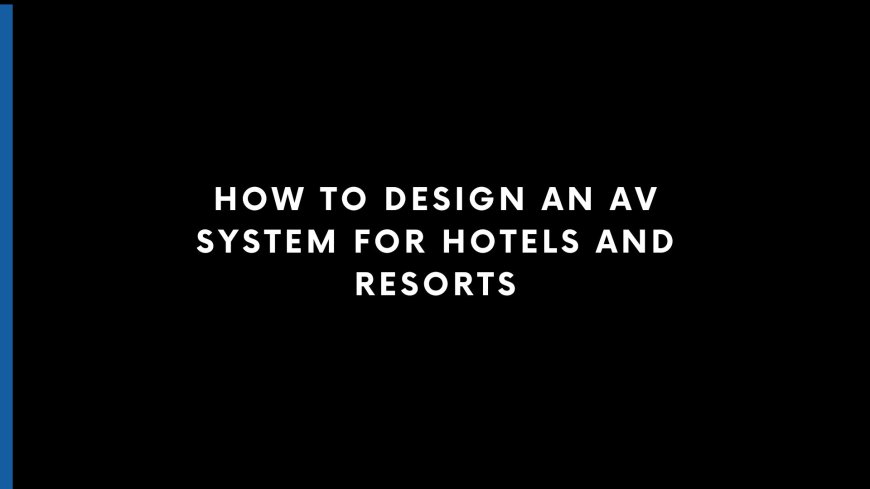How to Design an AV System for Hotels and Resorts
This blog will guide you through the essentials of designing an AV system for hotels and resorts, covering everything from planning to deployment.

When it comes to delivering an unforgettable guest experience, hotels and resorts are investing more than ever in advanced AV technology. Whether it is a luxury resort on the coast or a boutique hotel in the city center, the right AV system can set the tone, provide comfort, and increase operational efficiency. XTEN-AV offers the tools and automation needed to streamline AV design and implementation. This blog will guide you through the essentials of designing an AV system for hotels and resorts, covering everything from planning to deployment.
Introduction
Hotels and resorts serve a wide range of clientele with diverse needs. From business travelers requiring video conferencing to tourists expecting immersive entertainment, AV technology is essential across the board. Designing an AV system in hospitality spaces is about more than just installing equipment. It is about ensuring comfort, reliability, and adaptability in environments that demand high performance and minimal disruption.
Understand the Property Needs
Before jumping into the technical specifications, it is important to assess the scope of the hotel or resort. Start with a walk-through of the property. Identify key areas such as:
-
Lobbies
-
Guest rooms
-
Meeting and conference rooms
-
Restaurants and bars
-
Event ballrooms
-
Outdoor entertainment spaces
-
Gyms and spas
Each of these spaces has unique AV requirements. For example, lobbies may need digital signage and background music, while conference rooms may require high-end video conferencing solutions.
Define User Expectations
AV systems in hospitality settings should serve both the guests and the staff. Understanding what each group expects helps shape the design. Guests may expect seamless TV connections, easy access to entertainment, voice-activated controls, or music in public areas. On the other hand, hotel staff may need tools for paging, background audio, digital signage updates, and emergency alerts.
Designing with these users in mind ensures that the AV system contributes to a smooth and enjoyable experience for everyone on the property.
Centralized vs. Decentralized AV
Hotels and resorts often span large footprints. In such cases, you will need to decide whether a centralized AV system or a decentralized one makes more sense.
A centralized system places AV control and distribution in one hub. This can be efficient for maintenance and upgrades. However, it may require more complex cabling.
A decentralized system allows each area to have its own AV setup. This can offer more flexibility but might be harder to manage across larger properties.
Using AV system design tools like XTEN-AV can help you visualize both models and pick the one that aligns with the layout and operational goals of the property.
Selecting the Right Equipment
Choosing AV equipment for hospitality projects involves considering durability, ease of use, and integration capability.
-
Displays: Use commercial-grade TVs or monitors in guest rooms and common areas. For digital signage, ensure the displays support network control.
-
Audio Systems: Install ceiling speakers or wall-mounted speakers for background music. In large spaces like ballrooms, go with zoned audio systems with subwoofers for clarity.
-
Control Systems: Integrate touch panels or mobile control systems for lighting, sound, and visuals in event spaces.
-
Projectors and Screens: For conference rooms or event spaces, choose high-resolution projectors with ambient light handling capability.
-
Cameras and Microphones: Install PTZ cameras and ceiling microphones in meeting rooms to support hybrid events.
XTEN-AV offers built-in libraries of AV products and drag-and-drop features, allowing integrators to select equipment with ease during the design process.
Network and Infrastructure Planning
Network bandwidth and reliability are crucial in modern AV systems, especially when devices are connected via IP. Hotels often rely on shared networks for guest services, so AV traffic should not interfere with guest connectivity.
Separate VLANs, quality of service settings, and robust infrastructure planning should be part of your design. Ensure all AV endpoints have proper power and network access points. Use structured cabling where possible.
XTEN-AV can generate schematic diagrams and cable lists to help manage this complexity effectively.
Integration with Building Management Systems
Hotels and resorts often use building management systems for HVAC, lighting, and security. Your AV system should be capable of integrating with these for improved automation and energy savings. For example, AV systems in meeting rooms can be programmed to power down when rooms are unoccupied.
Such integrations not only make the hotel smarter but also reduce energy consumption and lower operational costs over time.
Ease of Use
Guests and staff will not tolerate complicated systems. The AV systems you design should be intuitive, with minimal training required. Remote control panels, presets for lighting and audio scenes, and user-friendly apps can help improve accessibility.
Keep interfaces consistent across different rooms and locations in the property. XTEN-AV allows designers to simulate user workflows and interface mockups to test for usability.
Maintenance and Support
Once installed, the AV system will require regular maintenance. Plan for remote monitoring capabilities to help troubleshoot issues before they affect guest experiences. Offer scalable support options such as:
-
Preventative maintenance schedules
-
Firmware and software updates
-
Remote diagnostics
Also consider designing redundancies into critical systems like emergency paging or conference room AV.
Budgeting and Phased Installations
Hotels and resorts may not deploy the full AV system at once due to budget constraints. Plan your design in phases. Start with high-impact areas like lobbies and event rooms, then expand to guest rooms and recreational zones.
XTEN-AV allows for modular project designs, making it easier to separate phases while keeping the overall architecture consistent.
Conclusion
Designing an AV system for hotels and resorts involves a careful mix of technology, user experience, and long-term planning. With XTEN-AV, AV integrators and designers can create customized layouts, automate documentation, and manage complex requirements from a single platform. From immersive guest rooms to high-functioning conference centers, an optimized AV design can elevate hospitality environments to deliver exceptional service and operational excellence.
Read more: https://jigseo.com/xten-av-at-the-forefront-of-worship-av-innovation/
Tags:
What's Your Reaction?
 Like
0
Like
0
 Dislike
0
Dislike
0
 Love
0
Love
0
 Funny
0
Funny
0
 Angry
0
Angry
0
 Sad
0
Sad
0
 Wow
0
Wow
0


































